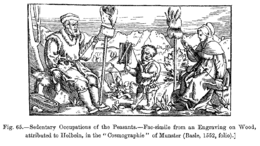Cosmography
This articleneeds additional citations forverification.(April 2024) |
The termcosmographyhas two distinct meanings: traditionally it has been theprotoscienceofmappingthe general features of thecosmos,heavenandEarth;more recently, it has been used to describe the ongoing effort to determine the large-scale features of theobservable universe.
Premodern views of cosmography can be traditionally divided into those following the tradition ofancient near eastern cosmology,dominant in theAncient Near Eastand inearly Greece.
Traditional usage
[edit]The 14th-century work'Aja'ib al-makhluqat wa-ghara'ib al-mawjudatbyPersianphysicianZakariya al-Qazwiniis considered to be an early work of cosmography. TraditionalHindu,BuddhistandJaincosmography schematize a universe centered onMount Merusurrounded by rivers, continents and seas. These cosmographies posit a universe being repeatedly created and destroyed over time cycles of immense lengths.

In 1551,Martín Cortés de Albacar,fromZaragoza,Spain, publishedBreve compendio de la esfera y del arte de navegar.Translated into English and reprinted several times, the work was of great influence in Britain for many years. He proposed spherical charts and mentioned magnetic deviation and the existence of magnetic poles.
Peter Heylin's 1652 bookCosmographie(enlarged from hisMicrocosmosof 1621) was one of the earliest attempts to describe the entire world in English, and is the first known description ofAustralia,and among the first ofCalifornia.The book has four sections, examining the geography, politics, and cultures of Europe, Asia, Africa, and America, with an addendum onTerra Incognita,including Australia, and extending toUtopia,Fairyland,and the "Land ofChivalrie".
In 1659, Thomas Porter published a smaller, but extensiveCompendious Description of the Whole World,which also included achronologyof world events fromCreationforward. These were all part of a major trend in theEuropean Renaissanceto explore (and perhaps comprehend) the known world.
Modern usage
[edit]Inastrophysics,the term "cosmography" is beginning to be used to describe attempts to determine the large-scalematter distributionandkinematicsof theobservable universe,dependent on theFriedmann–Lemaître–Robertson–Walker metricbut independent of the temporal dependence of thescale factoron the matter/energy composition of the Universe.[1][2] The word was also commonly used byBuckminster Fullerin his lectures.
Using theTully-Fisher relationon a catalog of 10000 galaxies has allowed the construction of 3D images of the local structure of the cosmos.[3]This led to the identification of a local supercluster named theLaniakea Supercluster[4]
See also
[edit]References
[edit]- ^Weinberg, Steven (1972).Gravitation and Cosmology: Principles and Applications of the General Theory of Relativity.Wiley. pp.407–463.ISBN978-0-471-92567-5.
- ^Visser, Matt (2005). "Cosmography: Cosmology without the Einstein equations".General Relativity and Gravitation.37(9): 1541–1548.arXiv:gr-qc/0411131.Bibcode:2005GReGr..37.1541V.doi:10.1007/s10714-005-0134-8.S2CID119414427.
- ^Said, Khaled (2023-10-24). "Tully-Fisher relation". In Di Valentino, E; Brout, D. (eds.).Hubble Constant Tension.arXiv:2310.16053.
- ^Tully, R. Brent; Courtois, Hélène; Hoffman, Yehuda; Pomarède, Daniel (2014-09-03)."The Laniakea supercluster of galaxies".Nature.513(7516): 71–73.arXiv:1409.0880.Bibcode:2014Natur.513...71T.doi:10.1038/nature13674.ISSN0028-0836.PMID25186900.S2CID205240232.
